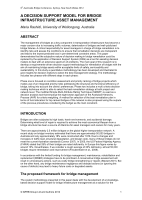Bridges

A Decision Support Model for Bridge Infrastructure Asset management
- Publication no: ABC-LCM202-14
- Published: 22 October 2014
- PDF (free) Download
The management of bridges as a key component in transportation infrastructure has become a major concern due to increasing traffic volumes, deterioration of bridges and well-publicised bridge failures. A critical responsibility for asset managers in charge of bridge remediation is to identify risks and assess the conditions to ensure that remediation decisions are transparent and lead to the lowest predicted loss in pre-determined constraint areas. This paper demonstrates that the subjective nature of decision making in bridge remediation could be replaced by the application of the Decision Support System as a tool for assisting decision makers to deal with an extensive spectrum of problems. The main goal of this research is to develop a requirements-driven decision support methodology for remediation of bridges with the aim of maintaining bridge assets within acceptable limits of safety, serviceability and sustainability. In this study a quantitative methodology has been developed and illustrated to give insights for decision makers to select the best management strategy. The methodology includes two phases with different steps in each phase.Phase one is focused on condition assessment and priority ranking of bridge projects which makes use of an integrated priority index addressing the structural and functional efficiency of the bridge, taking into account the clients preferences. Phase two includes a multi-criteria decision-making technique which is able to select the best remediation strategy at both project and network level. The modified Simple Multi Attribute Rating Technique is used as a decision-analysis tool that employs the eigenvector approach of the Analytical Hierarchy Process for criteria weighting. A method for selection of the best remediation plan in terms of fund allocation for the top ranked bridges of the network is also proposed using the outputs of the previous procedures considering the budget as the main constraint.
Related publications
WEB-AGBT07-24
Latest Bridges News
